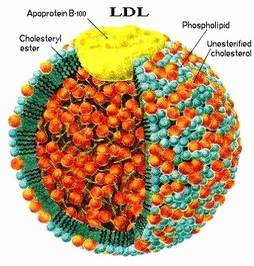'Good' and 'Bad' cholesterol explained

'Good' and 'bad' cholesterol
Let us scotch a myth: There is no such thing as 'good' and 'bad' cholesterol; HDL cholesterol and LDL cholesterol. Cholesterol is just one chemical compound and all cholesterol is exactly the same. Talking of LDL cholesterol and HDL cholesterol as if they were two different types of cholesterol is not only misleading, it is an outright lie. But then mendacity in medicine is not a rarity, it is a common practice.
Cholesterol is not water soluble. Cholesterol cannot travel freely on its own in the bloodstream to where it is needed. Cholesterol is transported in little packets together with other materials, notably fats, phospholipids and proteins as the graphic of LDL shows. These little packets are called lipoproteins, a contraction of the words 'lipid' (a class of substances which includes fats, cholesterol and waxes) and protein. LDL stands for Low-Density Lipoprotein and HDL is High-Density Lipoprotein. Neither LDL nor HDL is actually cholesterol, they are merely the carriers of cholesterol.
There are also other lipoproteins: VLDL (very low density lipoprotein), IDL (Intermediate density lipoprotein), and there is even an HDL2 and HDL3, and chylomicrons. And when your doctor measures your cholesterol level, he does not measure your cholestero. All he is measuring is the vehicles that carry cholesterol.
Even then, he can only measure total cholesterol and HDL. The rest, after HDL, is all lumped together and a guess is made about how much of that rest is LDL — as it is included with all the other lipoproteins.< /p>
Functions of LDL and HDL
So, you might ask: What is the difference between HDL and LDL? The difference between LDL and HDL is their function.The functions of the two lipoproteins are that LDL carries cholesterol from the liver out around the body to where it is needed for cell repair and all the other jobs that cholesterol does; and, as the body abhors waste and is a great recycler, HDL carries 'second-hand' cholesterol from cells being replaced back to the liverto be recycled.
Neither HDL nor LDL is 'bad'; both are essential.
Studies expose the cholesterol myth!
Three studies, all published in 2006, really scotched the myths about LDL and HDL. The first, published in the Journal of the American College of Cardiology, was to determine the relationship between established cardiovascular risk factors such as cholesterol, LDL, triglycerides, C-reactive protein, et cetera, and the extent of coronary atherosclerosis.[1]
The most significant finding was that LDL was NOT a predictor of greater disease.
This was confirmed by a joint Canadian and American group who also found that levels of LDL did not predict CHD.[2]
To rub this in, the third research team showed that it was raised levels of HDL which predicted recurrent coronary events in some heart attack patients.[3]
Studying the interaction between LDL, HDL and inflammation in the THROMBO (Postinfarction Thromogenic Factors and Recurrent Coronary Events) study, researchers showed that in a sub-group of patients, only elevated HDL was a significant and independent predictor of risk.
What these studies say, therefore, is that LDL is not 'bad' after all and HDL isn't necessarily 'good'. Which, of course, is the exact opposite of what we have been told for a quarter of a century.
Confirmation of the falsity of the LDL = 'bad' myth became apparent in 2007 with the publication of a study which showed that of 270,655 hospitalizations from 541 hospitals, fully half the patients hospitalised with coronary artery disease had very low LDL levels of less than 2.6 mmol/L (100 mg/dL);[4] and more than one in six had LDL levels below 1.8 mmol/L
References
1. Nicholls SJ, Murat Tuzcu E, Crowe T, et al. Relationship Between Cardiovascular Risk Factors and Atherosclerotic Disease Burden Measured by Intravascular Ultrasound. J Am Coll Cardiol 2006; 47:1967-1975.2. Liu J, Sempos CT, Donahue RP, et al. Non-High-Density Lipoprotein and Very-Low-Density Lipoprotein Cholesterol and Their Risk Predictive Values in Coronary Heart Disease. Am J Cardiol 2006; 98: 1363-1368
3. Corsetti JP, Zareba W, Moss AJ, et al. Elevated HDL is a risk factor for recurrent coronary events in a subgroup of non-diabetic postinfarction patients with hypercholesterolemia and inflammation. Atherosclerosis 2006; 187: 191-197.
4. Fonarow GC, Cannon CP, Deedwania PC, et al. Lipid Levels in Patients Hospitalized with Coronary Artery Disease: An Analysis of 136,905 Hospitalizations in GWTG-CAD. http://astute.cardiosource.com/2007/vposters/pdf/275_Fonarow.pdf.
Last updated 1 December 2011
Related Articles

 HOME
HOME


